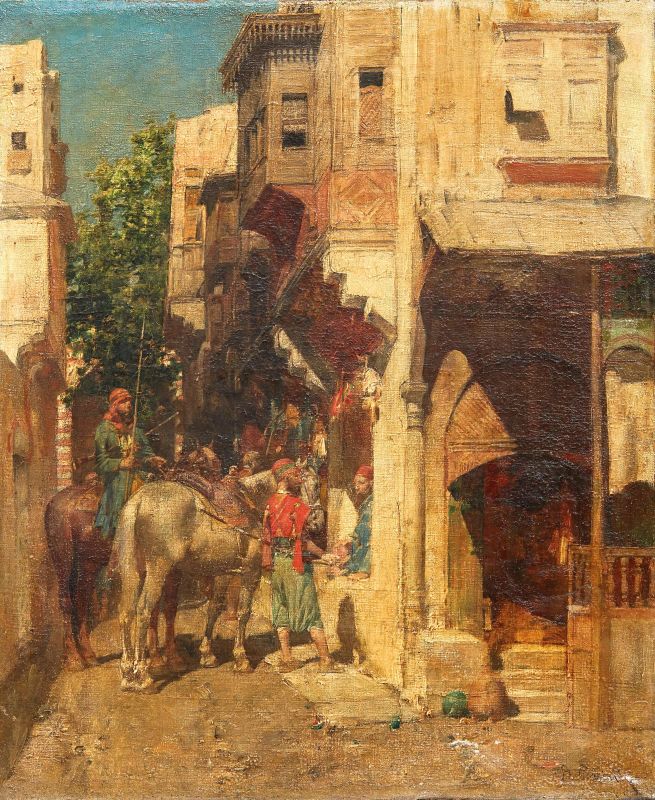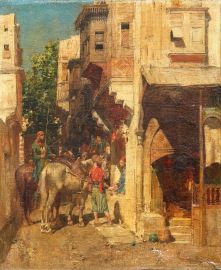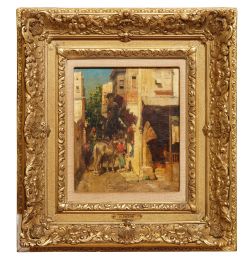Alberto Pasini
(Busseto 1826 - Cavoretto 1899)
SOUVENIR D’ORIENT
firmato in basso a destra
olio su tela
cm 27,5x22,4
SOUVENIR D’ORIENT
signed lower right
oil on canvas
10 ¾ by 8 13/16 in
Quella del pittore emiliano Alberto Pasini fu indubbiamente una vita in perenne movimento, dall’Italia all’Oriente a Parigi, che ci ha lasciato numerose testimonianze di mondi lontani e pittoreschi. Artista illustratore di viaggio per il ministro francese Prosper Bouree durante una missione diplomatica a Teheran nel 1855, città raggiunta attraverso Egitto, Arabia, Yemen, Persia a causa della guerra russo-turca, rimase affascinato da quel viaggio. Tornò quindi diverse volte in nord Africa e in medio oriente, soggiornando a Costantinopoli e in altre città. La sua è stata una produzione intensa, caratterizzata da una tavolozza dai colori brillanti e luminosi con cui è riuscito a creare palpitanti impressioni ispirate alle segrete bellezze delle architetture, al brulicare delle persone nei bazar, ai portali maestosi delle moschee. Talvolta, quei mondi remoti che tanto affascinavano la cultura borghese europea, il pittore li componeva su tele di dimensioni ridotte, come in questo caso, sapendo racchiudere in uno spazio limitato da edifici di pietra chiara, descritti con minuziosità nei dettagli decorativi, i quartieri cittadini animati dalla confusione e dai colori di una terra lontana. Il dipinto raffigura la sosta di due uomini, uno dei quali rimasto a cavallo, mentre l’altro si avvicina al banco di pietra del bazar. Nonostante il vicolo sia chiuso sullo sfondo dall’incombenza di un albero carico di fogliame, il pittore trova modo di lasciare spazio a un cielo terso e luminoso.
The artist Alberto Pasini, who hailed from the Emilia Region of Italy, was constantly on the move, travelling from Italy to the Orient to Paris and left us many images of distant and picturesque places. He was the travel illustrator for the French government minister Nicolas Prosper Bourée during a diplomatic mission to Teheran in 1855, that they reached via Egypt, Arabia, Yemen and Persia because of the Russo-Turkish War, better known as the Crimean War was fascinated by the journey. He returned to North Africa and the Middle East several times thereafter, and stayed in Constantinople and other cities. His oeuvre is intense, characterized by a palette of bright luminous colours with which he created pulsating impressions inspired by the secret beauties of the buildings and architecture in general, the teeming bazaars and the majestic doors of the mosques. Sometimes the artist depicted the distant places that fascinated the European bourgeoisie on small canvases, such as this painting. He succeeded in rendering a city’s district with all of its bustle, colours and minute decorative details in a space bounded by pale stone buildings. Our painting portrays two men – one still astride his horse, and the other in front of a stone counter at a bazaar. Even though the back of the alley is closed by a big tree laden with leaves, the artist found the way to leave room for a bright, clear sky.






